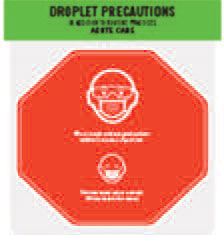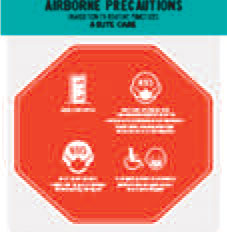Additional Precautions
Additional Precautions are interventions used in addition to Routine Practices when necessary. The need for Additional Precautions is based on the mode of transmission of microorganisms (e.g., MRSA, VRE, C. difficile).
Categories of Additional Precautions:
Organizational Accountabilities:
Additional Precautions must be instituted as soon as symptoms suggestive of a transmissible infection are noted, not only when a diagnosis is confirmed. Each health care setting should have a policy authorizing any regulated health care professional to initiate the appropriate Additional Precautions at the onset of symptoms and maintain precautions until laboratory results are available to confirm or rule out the diagnosis.
Contact Precautions
Contact transmission is the most common route of transmission of infectious agents. There are two types of contact transmission:
1. Direct – transmission of microorganisms via touching contaminated individual
2. Indirect – transmission of microorganisms via contact with contaminated objects
Droplet Precautions
Droplet transmission occurs when droplets carrying an infectious agent exit the respiratory tract of a person. Droplets can be generated when a patient/client talks, coughs or sneezes and through some procedures performed on the respiratory tract (e.g., suctioning, bronchoscopy or nebulized therapies). Droplets do not remain suspended in the air and usually travel less than two metres.
Airborne Precautions
Common organisms transmitted via the air (airborne) include:
Patients with a known or suspected airborne organism should be cared for in an Airborne Infection Isolation Room (AIIR) with the door closed. The important characteristics of an airborne room AIIR are that it be:
single-patient
negative pressure to the corridor/adjacent areas with audiovisual alarms
have a minimum of 12 air exchanges/hour (either using the facilities ventilation system or by using HEPA filtration of the air in the room)
have air flow that is designed to move air from the area of the patient’s head/face away from the likely position(s) of health care workers
Even after a patient has left the room everyone entering the room must wear an N95 respirator for the time period specified in your employer’s policy.
Essential Elements of Additional Precautions
Special Accommodation Considerations (e.g., a single room with private toileting facilities is highly recommended)
Signage (i.e., that lists the required precautions)
Dedicated equipment, whenever possible
Appropriate PPE
Additional cleaning measures
Transportation considerations (e.g., restricted patient/client movement outside of their room)
Effective Communication with all members of the healthcare team (e.g., patient/client, their family members, other healthcare providers)
Did You Know?
Equipment and supplies that are required for the interaction (and cannot be left in the room) should be assembled first and brought into the room after PPE has been put on.
Additional Precautions in an Acute Care Setting
| CONTACT | DROPLET | AIRBORNE | |
|---|---|---|---|
| Special accommodation considerations | Single room with dedicated toilet and patient sink – door may be open | Single room with dedicated toilet and patient sink – door may be open | AIIR Keep door closed |
| Signage (examples) |  |  |  |
| Dedicated equipment | Dedicated equipment if possible | Dedicated equipment if possible | As per Routine Practices |
| Appropriate PPE | Gloves at all times Gown if skin or clothing will come in contact with the patient/client environment | Facial protection within 2 meters of patient/client | Only immune staff for measles, varicella (no N95 required) Don N95 fit tested respirator and do seal check prior to entry Doff N95 respirator outside patient room. |
| Additional cleaning measures | VRE and C diff rooms require special cleaning (routine cleaning for all others) | Routine Cleaning | Routine Cleaning |
| Transportation considerations | Transport staff to wear gloves and gown for direct contact with patient/client during transport | Patient/client to wear a surgical (procedure) mask during transport Transport staff to wear the appropriate mask during transport Limit transport unless required for diagnostic or therapeutic purposes | Patient/client to wear a surgical (procedure) mask during transport Transport staff to wear an N95 during transport Limit transport unless required for diagnostic or therapeutic purposes |
For more information on Additional Precautions in Complex Continuing Care, Long-Term Care, Ambulatory Settings and Home Care, please see Infection Prevention and Control for Long-Term Care Homes (publichealthontario.ca)
References
Association for the Advancement of Medical Instrumentation (AAMI). (2015). FDA proposes new criteria for surgical gowns. Retrieved from Association for the Advancement of Medical Instrumentation website: www.aami.org/newsviews/newsdetail.aspx?ItemNumber=2650
Canadian Patient Safety Institute. (n.d.). Ventilator-associated pneumonia (VAP). Retrieved from Canadian Patient Safety Institute website: www.patientsafetyinstitute.ca/en/topic/pages/ventilator-associatedpneumonia-(vap).aspx
Centers for Disease Control and Prevention. (2011). Central line-associated bloodstream infections: Resources for patients and healthcare providers. Retrieved from Centers for Disease Control and Prevention website: www.cdc.gov/HAI/bsi/CLABSI-resources.html
Critical Care Secretariat. (2012). Ventilator associated pneumonia and central line infection prevention toolkit. Retrieved from Critical Care Services Ontario website: www.criticalcareontario.ca/EN/Toolbox/Performance%20Improvement%20Collaborative/VAP%20and%2 0CLI%20Toolkit%20(2012).pdf
Immunize Canada. (2016). ImmunizeCA app. Retrieved from Immunize Canada website: http://immunize.ca/en/app.aspx
Loeb, M., Dafoe, N., Mahony J., John, M., Sarabia, A., Glavin, V., Walter, S.S. (2009). Surgical mask vs N95 respirator for preventing influenza among health care workers: A randomized trial. JAMA, 302(17), 1865- 1871. doi:10.1001/jama.2009.1466. Retrieved from http://jama.jamanetwork.com/article.aspx?articleid=184819
PIDAC. (2012a). Best practices for infection prevention and control programs in Ontario (3rd ed.). Retrieved from Public Health Ontario website: www.publichealthontario.ca/en/eRepository/BP_IPAC_Ontario_HCSettings_2012.pdf
PIDAC. (2012b). Routine practices and additional precautions in all health care settings (3rd ed.). Retrieved from Public Health Ontario website: www.publichealthontario.ca/en/eRepository/RPAP_All_HealthCare_Settings_Eng2012.pdf
PIDAC. (2013). Annex B: Best practices for prevention of transmission of acute respiratory infection in all health care settings. Retrieved from Public Health Ontario website: www.publichealthontario.ca/en/eRepository/PIDAC-IPC_Annex_B_Prevention_Transmission_ARI_2013.pdf
PIDAC. (2014). Best practices for hand hygiene in all health care settings, (4th ed.). Retrieved from Public Health Ontario website: www.publichealthontario.ca/en/eRepository/2010-12%20BP%20Hand%20Hygiene.pdf
PIDAC. (2015a). Best practices for prevention, surveillance and infection control management of novel respiratory infections in all health care settings. Retrieved from Public Health Ontariowebsite: www.publichealthontario.ca/en/eRepository/Best_Practices_Novel_Respiratory_Infections.pdf
PIDAC. (2015b). Infection prevention and control for clinical office practice. Retrieved from Public Health Ontario website: www.publichealthontario.ca/en/eRepository/IPAC_Clinical_Office_Practice_2013.pdf
PIDAC. (2016). Tools for preparedness: Triage, screening and patient management for Middle East Respiratory Syndrome Coronavirus (MERS-CoV) infections in acute care settings. Retrieved from Public Health Ontario website: www.publichealthontario.ca/en/eRepository/PIDAC-IPC_Preparedness_Tools_MERS_CoV_2013.pdf
Public Health Agency of Canada. (2013). Canadian immunization guide. Retrieved from Public Health Agency of Canada website: http://phac-aspc.gc.ca/publicat/cig-gci/p03-work-travail-eng.php#a1
Public Health Agency of Canada. (2014). Canadian Tuberculosis Standards (7th ed.). Retrieved from http://www.phac-aspc.gc.ca/tbpc-latb/pubs/tb-canada-7/assets/pdf/tb-standards-tb-normes-prefeng.pdf
Public Health Agency of Canada. (2016). Summary of assessment of public health risk to Canada associated with Middle East Respiratory Syndrome Coronavirus (MERS-CoV). Retrieved from Public Health Agency of Canada website: www.phac-aspc.gc.ca/eri-ire/coronavirus/risk_assessment-evaluation_risque-eng.php
Public Health Ontario. (n.d.a). Chain of transmission and risk assessment: Glossary of terms. Retrieved from Public Health Ontario website: www.publichealthontario.ca/en/LearningAndDevelopment/OnlineLearning/InfectiousDiseases/IPACCore/Documents/CORE_Trainers_COT_and_RA_Module_Glossary_April _2014.pdf
Public Health Ontario. (n.d.b). Risk Algorithm to Guide PPE Use. Retrieved from Public Health Ontario website: www.publichealthontario.ca/en/eRepository/IPAC_Clinical_Office_Practice_Risk_Algorithm_PPE_2013.pdf
World Health Organization. (2015). Middle East respiratory syndrome coronavirus (MERS-CoV). Retrieved from World Health Organization website: www.who.int/mediacentre/factsheets/mers-cov/en/
